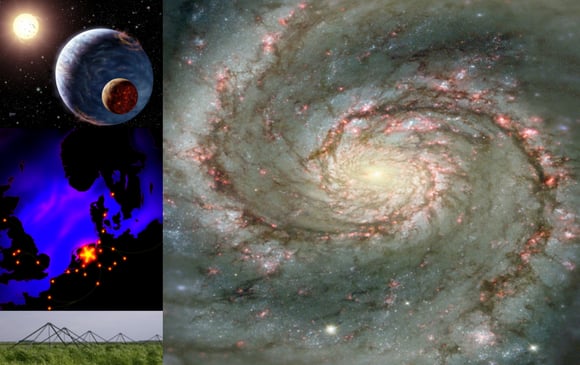Since the 1960's astronomers have been scanning the heavens, searching for radio signals beamed towards the vicinity of Earth by other intelligent beings. But so far, no ET signals have been found. However, no radio telescope has been able to search the very low frequency radio spectrum, which could possibly include "leakage" of extraterrestrial "everyday" signals that a distant civilization might emit, such as television and radio signals. But a new radio telescope called
LOFAR
(the Low Frequency Array), will have that ability. Currently being built by ASTRON, (the Netherlands Foundation for Research in Astronomy), LOFAR consists of about 25,000 small antennas that will receive signals from space, and offers the ability to search these low-frequency type of radio waves.
According to Professor Michael Garrett, General Director of ASTRON, LOFAR is well suited to SETI research. "LOFAR can extend the search for extra-terrestrial intelligence to an entirely unexplored part of the low-frequency radio spectrum, an area that is heavily used for civil and military communications here on Earth. In addition, LOFAR can survey large areas of the sky simultaneously - an important advantage if SETI signals are rare or transient in nature."
Astronomers believe of the approximately 100 thousand million stars in the galaxy, most of these have planetary systems. Some of these planets might actually be suitable for life and many scientists believe that life is probably wide-spread across the galaxy. However, technically advanced civilizations might be relatively rare or at least widely separated from each other.
Despite the huge distances between stars, the next generation of radio telescopes, such as LOFAR, begin to offer the possibility of detecting radio signals associated with extraterrestrial radio and TV transmitters.
Dan Werthimer, a SETI@home project Scientist at the University of Berkeley said, "SETI searches are still only scratching the surface, we need to use as many different telescopes, techniques and strategies as possible, in order to maximize our chances of success."
Professor Garrett thinks it is high time European scientists began to support their colleagues from the United States in this exciting area of research. "I cannot think of a more important question humanity can ask and perhaps now answer. Are we truly alone in the Universe or are there other civilizations out there waiting to be discovered? Either way, the implications are tremendous."
LOFAR will begin its scans of low frequency radio waves when the array is completed in 2009.
Original News Source: ASTRON
 Universe Today
Universe Today
